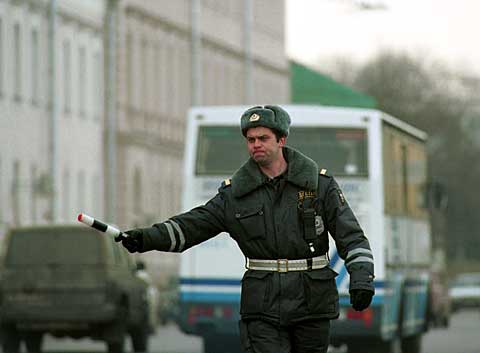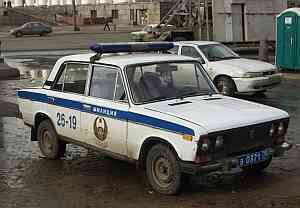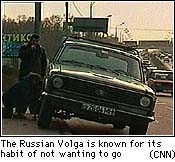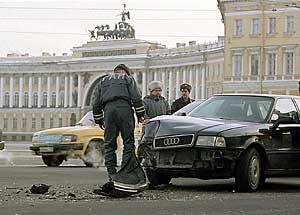|
|
ST PETERSBURG ON WHEELS by Tony Davis* Throw your hand in the air and any average car - be it a Lada, Moscvich, Volga or VAZ - will pull up within seconds. In a city as starved of taxis and money as St Petersburg, virtually every car in the city is an unofficial cab prepared to drive half an hour or more out of its way for as little as $1.50. That is of course providing the passenger is a Russian. In a city where the famous Winter Palace-Hermitage Museum now charges more than 100 times as much for foreigners as locals, people who talk funny are considered fare game. Our unofficial guide, a university student named Gleb who negotiated the $1.50 fee for the above-mentioned ride, says the standard taxi fare for foreigners is now $10.00 US dollars or more, no matter how short the journey. And the trip between the airport and the centre of the city has been subjected to some pretty rigid price fixing by a new breed of budding capitalists. Expect to hear every driver of an official taxi declare that his meter is broken. And expect to pay between $30 to $50 for the half hour trip. What about grabbing a hire car? The difficulties are enormous and include the fact that few cars in St Petersburg are insured, so any accident is going to cost you, no matter who is to blame.
Conversely, if you do pull up, they can in theory impound your car for any suspected infringement of the safety or registration laws. However, as is the custom almost everywhere in Russia nowadays, many of the automobile police will make special concessions for those who pull out their wallet and use the magic phrase 'I don't need a receipt'. The story is not apocryphal. Our driver was pulled over and quite openly handed across money to a policeman, who allowed us to continue. Other auto idiosyncrasies include a depressingly high rate of theft and vandalisation and roads so potholed that they will rip apart suspension. This last point leads to a local habit of violently swerving across the road at full clip to avoid the thud of steel and rubber. The wary driver has to look out for potholes not only in front of his own car but in front of the people driving around him. Fuel, however, is remarkably cheap by Western European standards. One litre costs around 27 Australian cents. OK, it's only 76 octane, but for a bit extra you can have 93 octane or - for a substantial premium - 98. And parking is no problem. It doesn't even seem to be a requirement that you do it parallel to the curb or with all wheels still on the roadway. Unlike Moscow, there are no parking meters. St Petersburg - 'the Venice of the North' - is a beautiful though dirty city pulsing with change and hungry for progress. Our friend Gleb is optimistic about the changes, though he phrases it in a typically sardonic Russian way. 'We say that an engineer used to have to work 800 years to buy a car, but with the reforms it is now only 750'. The real numbers are not entirely different. Take the price of a Lada Samara which is, by Russian standards, a modern car. Due to extreme inflation, the newspaper advertisements quote the prices in US dollars with the conversion in roubles to be finalised on the day of delivery. The Lada Samara 1.5 hatchback is priced at US$6000. A whitecollar government employee - whether doctor, schoolteacher or police officer - earns between $30 and $80 per month. But the government is constantly short of funds and is often three months late in paying wages. With inflation running at 11-13 per cent per month, that further devalues this modest remuneration.
Expensive to start with, and attracting up to 100 per cent import duty, these German luxury cars are the almost exclusive preserve of the new mafiosi, who are currently pulling in so much money from so many different shonky sources that Russia's most expensive restaurants are too dear for even wealthy German and Japanese tourists. St Petersburg has been divided into regions by the Russian mafia and apparently even buskers are paying protection money to ply their trade. The most common identifying features of a member of the mafiosi is a crew-cut hairstyle, a black leather jacket, a peaked cap and a 7-Series BMW. Another is that they are usually reversing across a packed pedestrian crossing at 40km/h or turning right from the left lane through a red light. 'People in normal cars are terrified of having a collision with these cars', one hire car driver told us, 'because it doesn't matter whose fault it is - you know that the people will get out and have crewcuts and with the help of a gun they will rip you off. They will get you to sign over your car or your flat.' In St Petersburg even the dearest cars are covered in mud and grime. Unfortunately, all my motoring in Russia was done from the back seat, the most exciting bit being a drive in an official cab complete with broken meter. The car was a largish Volga, the driver was a stone faced, middle-aged aspiring Formula One pilot. As we hauled our luggage toward the car he opened the bootlid to reveal the cargo area was already filled with an empty Jerry can, an empty milk crate and a lot of dirt. If nothing else, this demonstrated that there really is an international bond between cab-drivers. The Volga, probably from the mid-1980s, looked and felt like a 1960s Fiat, albeit a big and luxurious one. The driver cranked it up to about 90km/h swerving through the night traffic and providing the passengers with what looked like a life-sized video arcade game. Rushing past were some of the world's most famous baroque and neo-classical architecture, of more interest to us at that time was the fact that the road was wet in parts, dry in others and icy in between. Added to this were gargantuan potholes and trolley bus tracks, which often stand many centimetres proud of the road and cause cars to change direction or bounce clear into the air. Even where the road was smooth, our driver was forced to make liberal steering inputs just to keep the car travelling straight ahead. The horn was never used, no matter how close we came to other traffic (and we came very, very close). Local law prevents the use of the horn, and it seems to be the only law everyone obeys.
No, we didn't hit and no, the driver's poker face didn't acknowledge that this was anything out the ordinary. The St Petersburg motoring experience, however, is not composed exclusively of exciting near misses. Seatbelts are widely ignored and the mechanical condition of many cars is atrocious. The week before we arrived there were 41 serious traffic accidents in the city, resulting in 17 deaths. And a State Automobile Inspectorate policeman was shot in the head, the second to be killed 'in action' this year. *Tony Davis is a Herald (Fairfax) journalist and a prolific author of automotive books. More stories by this writer: Links: St Petersburg Times (EN)
|
||||||

 GET
BEST RATES FOR ST. PETERSBURG HOTELS
GET
BEST RATES FOR ST. PETERSBURG HOTELS A
second difficulty is that the main streets are lined with a plethora
of State Automobile Inspectorate policeman who have the right to pull
you over at any time and inspect the endless paperwork you are required
to carry. No place - even halfway around a roundabout - is considered
too inconvenient. They merely blow a whistle and hold up a baton and
if you fail to pull up, the policeman apparently has the right to open
fire on your car.
A
second difficulty is that the main streets are lined with a plethora
of State Automobile Inspectorate policeman who have the right to pull
you over at any time and inspect the endless paperwork you are required
to carry. No place - even halfway around a roundabout - is considered
too inconvenient. They merely blow a whistle and hold up a baton and
if you fail to pull up, the policeman apparently has the right to open
fire on your car.  So
for the vast majority of Russians a car is but an elusive dream. The
roads nonetheless are filled with a wide variety of vehicles, mostly
Russian-built and many in a very poor state. Cheaper imports (older
Mazdas, Fords and Volvos, usually via Finland) are the next most common
vehicles, followed by a surprisingly large and growing number of brand
new Mercedes, BMWs and Audis.
So
for the vast majority of Russians a car is but an elusive dream. The
roads nonetheless are filled with a wide variety of vehicles, mostly
Russian-built and many in a very poor state. Cheaper imports (older
Mazdas, Fords and Volvos, usually via Finland) are the next most common
vehicles, followed by a surprisingly large and growing number of brand
new Mercedes, BMWs and Audis.  When
a oncoming car turned across our path, our driver got his best chance
to put his well-worn piece of Soviet machinery to the test. There are
no words which quite explain the sensation of sitting above four drum-braked
wheels which are skating, squirming and bouncing over a surface made
up of bitumen, mud, steel, pebbles and clear air. But the eyes opened
fairly wide as the rogue car got ever closer.
When
a oncoming car turned across our path, our driver got his best chance
to put his well-worn piece of Soviet machinery to the test. There are
no words which quite explain the sensation of sitting above four drum-braked
wheels which are skating, squirming and bouncing over a surface made
up of bitumen, mud, steel, pebbles and clear air. But the eyes opened
fairly wide as the rogue car got ever closer.